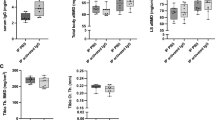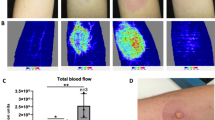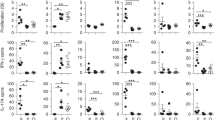Abstract
N. A. MITCHISON1 first showed that the power to transfer immunity caused by lymphosarcoma 6C3HEDto non-susceptible mice is confined to the lymph nodes draining the site of implantation. Billingham et al. 2 also found that in mice the tissues of the host which have the power to transfer immunity to skin homografts are the regional nodes and to a lesser degree the spleen. Gallone3 and his colleagues had previously shown that an increase in pyroninstaining cells occurred in the lymph nodes draining skin homografts. This work was confirmed and extended by Scothorne and McGregor4, who showed that in rabbits a considerable increase in weight occurred in lymph nodes draining homografts, but not autografts, of skin. Further, they showed that after homografting, great accumulations of ‘large lymphoid cells’ appeared in the cortex and to a lesser extent in the medullary cords of the draining lymph nodes. The cellular response waned rapidly with the onset of graft destruction, and within two days the nodes were largely depleted of pyroninophilic elements. Radici and Piredda5, also using rabbits, have described how, five days after a skin homograft, the reticular cells of the medullary cords of the first regional node are in large part replaced by pyroninophilic cells. Craigmyle6, however, using cartilage, was able to show that the weight changes and cyto-logical alterations in the regional lymph nodes occurred, but only in response to second-set homo-grafts and first-set heterografts of cartilage. He concluded that cartilage in the rabbit is only mildly antigenic.
This is a preview of subscription content, access via your institution
Access options
Subscribe to this journal
Receive 51 print issues and online access
$199.00 per year
only $3.90 per issue
Buy this article
- Purchase on Springer Link
- Instant access to full article PDF
Prices may be subject to local taxes which are calculated during checkout
Similar content being viewed by others
References
Mitchison, N. A., Proc. Roy. Soc., B, 142, 72 (1954).
Billingham, R. E., et al., Proc. Roy. Soc., B, 143, 58 (1954).
Gallone, L., et al., Arch. Atti Soc. Ital. Chir., 2, 329 (1952).
Scothorne, R. J., and McGregor, I. A., J. Anat. (Lond.), 89, 283 (1955).
Radici, G., and Piredda, A., Giornale Ital. di Dermat., 1, 49 (1957).
Craigmyle, M. B. L., J. Anat. (Lond.), 92, 75 (1958).
Fisher, R. A., “Statistical Methods for Research Workers”, tenth ed. (Oliver and Boyd, 1946).
Author information
Authors and Affiliations
Rights and permissions
About this article
Cite this article
BURWELL, R., GOWLAND, G. Lymph Node Reactivity to Homografts of Cancellous Bone. Nature 188, 159–160 (1960). https://doi.org/10.1038/188159a0
Issue Date:
DOI: https://doi.org/10.1038/188159a0
This article is cited by
Comments
By submitting a comment you agree to abide by our Terms and Community Guidelines. If you find something abusive or that does not comply with our terms or guidelines please flag it as inappropriate.



